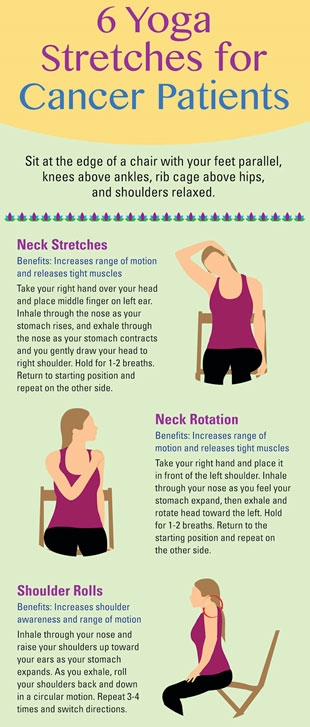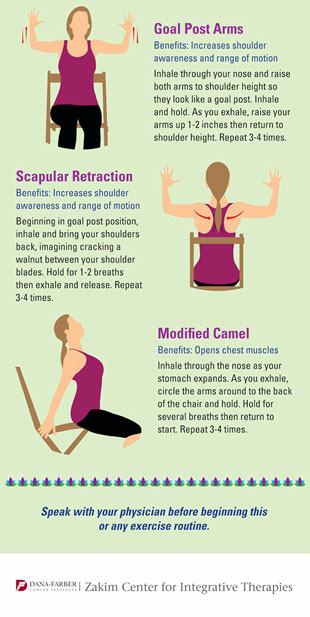Yoga, meaning “union,” is a 5,000-year-old system of principles and practices originating in India. Most types of yoga practiced in the United States focus on movement and breathing, the most frequently practiced being hatha yoga. Hatha yoga uses physical poses and breathing techniques to increase strength, flexibility, and well-being. Research on the benefits of yoga for breast cancer patients has shown that it can: improve physical vitality, reduce fatigue, reduce stress, improve sleep, and improve quality of life. To learn more about the benefits and precautions of yoga for people with breast cancer, listen to a podcast for breastcancer.org by Vicki Flannery, a nurse, yoga instructor, and breast cancer survivor.
If you are interested in trying yoga, there are plenty of free resources online for guided workouts. For example, LiveWell After Breast Cancer, a Johns Hopkins Sidney Kimmel Cancer Center initiative, offers fun and easy exercise routines, including guided yoga workouts. Mass General Cancer Center also offers a gentle yoga practice video instructed by Luba Zagachin, Mass General yoga instructor.
Important risk factors to consider before trying yoga:
- Risk of inexperienced instructors. Ask your oncologist or cancer center staff to recommend highly trained instructors who regularly work with cancer patients.
- Risk of lymphedema. If you have recently had lymph nodes removed, some of the more strenuous yoga types and poses may present a risk. An instructor who has taught breast cancer patients will be aware of safe yoga types and poses.
- Risk of fracture in patients with bone metastasis. If you have bone metastasis, ask your doctor if yoga is right for you, or if a gentler form of yoga, such as mediated or guided imagery, would be more fitting.
There is ongoing research about the impact of mind-body interventions on the health of cancer patients. At the 2003 meeting of the American Society of Clinical Oncology (ASCO), results from a yoga study of 126 women showed that women who did yoga while receiving chemotherapy or hormonal therapy had a 12% improvement in fatigue, physical functioning, and quality of life. In 2006, a study from the MD Anderson Cancer Center reported that women who took yoga classes twice a week while receiving radiation treatment reported having more energy and less daytime sleepiness, better physical functioning, and better overall quality of life.
Research from The University of Texas MD Anderson Cancer Center found that patients who participated in yoga exercises that incorporated controlled breathing, meditation and relaxation techniques into their treatment plan experienced improved ability to engage in their daily activities, better general health and better regulation of cortisol (stress hormone). The study also found that women in the yoga group were better equipped to find meaning in the illness experience. Dr. Lorzeno Cohen, principal investigator of the study and director of MD Anderson’s Integrative Medicine Program, emphasized that “research has shown that yoga and other types of mind-body practices, incorporated into the standard of care, can help improve patient outcomes, particularly quality of life.” Following the results of this study, The National Cancer Institute awarded more than $4.5 million to MD Anderson to conduct a Phase III trial in women with breast cancer that investigates improvement in physical function and quality of life during and after radiation treatment. This marks the largest amount ever awarded by NCI for the study of yoga in cancer and emphasizes the growing importance of relaxation-based interventions that can contribute to the well-being of people with cancer.


Resources
MD Anderson Cancer Center, and Null. “Yoga Gets Resounding Support From NCI,” July 27, 2010. https://www.mdanderson.org/publications/conquest/yoga-get-nci-support.h34-1585890.html.
MD Anderson Cancer Center, and Null. “Yoga Gets Resounding Support From NCI.” MD Anderson Cancer Center. MD Anderson Cancer Center, July 27, 2010. https://www.mdanderson.org/publications/conquest/yoga-get-nci-support.h34-1585890.html.
Release, MD Anderson News. “Yoga Regulates Stress Hormones and Improves Quality of Life for Women with Breast Cancer Undergoing Radiation Therapy.” MD Anderson Cancer Center, March 3, 2014. https://www.mdanderson.org/newsroom/yoga-regulates-stress-hormones-and-improves-quality-of-life-for-.h00-158906967.html.
Simon, Stacy. “Say Yes to Yoga.” American Cancer Society, May 15, 2020. https://www.cancer.org/latest-news/say-yes-to-yoga.html.
“What Are the Best Yoga Poses for Breast Cancer Patients? [Infographic]: Dana-Farber Cancer Institute.” Dana, December 19, 2018. https://blog.dana-farber.org/insight/2016/04/what-are-the-best-yoga-poses-for-breast-cancer-patients-infographic/.
“Yoga Shows Benefits to Quality of Life in Some Breast Cancer Patients.” NCI Formulary, August 12, 2013. https://cam.cancer.gov/health_information/highlights/breastcancer_yoga.htm.
“Yoga.” Breastcancer.org, May 5, 2020. https://www.breastcancer.org/treatment/comp_med/types/yoga.
“Yoga.” Susan G. Komen®. Accessed August 3, 2020. https://ww5.komen.org/BreastCancer/Yoga.html.